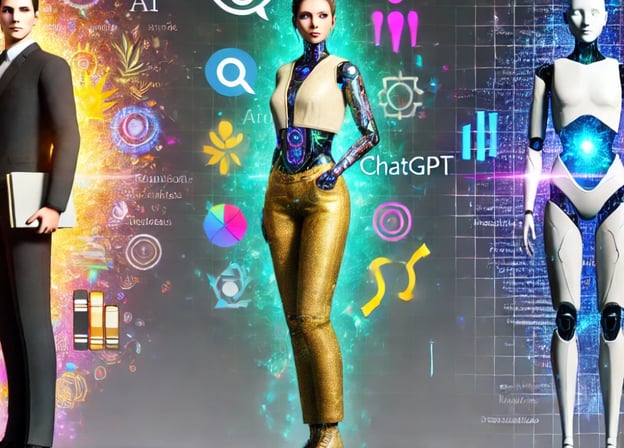Newsletter #014
Gene Da Rocha MSc BSc (Hons)
September 12, 2024
Hello everyone,
I hope you're doing well and gaining more knowledge about AI and related subjects.
After publishing over 150 articles on https://voxstar.substack.com/, I have decided to post on Linkedin first and then a link to this article on all other channels.
I am covering news updates regarding AI Technology, Medical, Automotive and Seed Finance. Additionally, I am drawing from my experience at companies like Volvo, Selfridges, and Carphone Warehouse and many more over a 40+ year career.
I'm particularly interested in exploring how AI can enhance the customer experience, streamline the creation of new products and apps, and encourage greater participation in the AI industry. I have now included AI Automotive and AI Healthcare subjects as well.
if you want me to include a particular topic or subject, please comment or message me via Linkedin.
Welcome to the New 14th version, edition version of AI AND AUTOMATION, your go-to source for the latest trends, tips, and techniques. This week, we're diving deep into the art and science of Prompt Engineering, an essential skill for anyone working with AI models like ChatGPT.
Mastering Prompt Engineering: Tips for Claude, Gemini, and ChatGPT
Prompt engineering has become an essential skill for anyone working with AI language models like Claude, Gemini, and ChatGPT. These models excel at generating human-like text based on your input, but to unlock their full potential, you need to communicate effectively with them. This requires refining your prompts to get accurate, insightful, and creative responses.
Here’s a guide on how to improve your prompt engineering skills using Claude, Gemini, and ChatGPT, with practical tips for each model.
Understanding the Models
Before diving into specific tips, it’s important to know that while these models share similarities, they also have unique capabilities.
Claude: Created by Anthropic, Claude focuses on generating helpful, safe, and precise answers. It’s designed to limit harmful or biased responses, making it suitable for sensitive tasks.
Gemini: Google DeepMind’s Gemini excels in research-oriented tasks, providing high-quality, factual, and structured responses. It’s especially useful for problem-solving and technical tasks.
ChatGPT: Known for its versatility, ChatGPT by OpenAI can handle a wide range of tasks, from casual conversation to code generation and content creation. Its strength lies in adaptability to different types of queries.
1. Be Specific and Clear with Your Requests
All three models benefit from specific, clear prompts. The more context you provide, the better they can understand your intent.
Example:
Vague prompt: “Tell me about AI.”
Improved prompt: “Explain the role of AI in automating customer service, focusing on chatbots and virtual assistants.”
By adding details, you direct the model toward a more accurate response. This applies equally to Claude, Gemini, and ChatGPT.
2. Experiment with Different Formats
Don’t hesitate to rephrase your prompt or experiment with various ways of asking the same question. Each model might interpret your words slightly differently.
Example for Claude:
Instead of: “How do I improve team productivity?”
Try: “What are some strategies to boost productivity in a remote team setting?”
Claude is great at handling prompts that request practical advice with nuanced scenarios, and this approach can produce more tailored responses.
3. Use Step-by-Step Instructions for Complex Queries
When asking about complex processes or requesting detailed explanations, it's best to break down the query into manageable steps. This method works exceptionally well with ChatGPT and Gemini.
Example for Gemini:
“Can you outline the steps to perform sentiment analysis on customer feedback using Python?”
Instead of a general answer, Gemini will provide a structured response, often with relevant code snippets or methods, ensuring you get a deeper, technical answer.
4. Provide Examples for Context
Offering examples in your prompt helps the model to understand the context better, especially when seeking creative or content-based responses.
Example for ChatGPT:
“Generate a catchy title for a blog post about AI in healthcare. Examples of titles I like: ‘Revolutionizing Medicine with AI’ and ‘AI: The Future of Healthcare Innovation.’”
This technique helps ChatGPT zero in on the tone, style, or angle you're looking for.
5. Leverage Few-Shot Learning for Advanced Tasks
Few-shot learning is a powerful technique where you provide the model with a few examples of what you're looking for. This approach can be very effective with more sophisticated models like Claude and Gemini.
Example for Claude:
“I need help drafting an email. Example 1: ‘Hi Team, Please remember the meeting at 10 AM tomorrow.’ Example 2: ‘Hello John, I wanted to confirm our lunch meeting at noon next Tuesday.’ Can you help draft a similar email for a project update?”
By giving out some examples, you train the model to understand the tone and style, leading to more personalized and contextually appropriate responses.
6. Fine-tune for Creativity or Precision
Different tasks may require different levels of creativity or precision. For creative writing, ChatGPT is excellent when you encourage exploration with prompts like, “Imagine a futuristic world where AI governs society. What challenges do people face?” For precision, Gemini excels when tasked with research-heavy, factual responses.
Example for Gemini:
“Provide an analysis of the impact of blockchain technology on global finance, focusing on regulatory challenges.”
The key is to know which model fits the job. Claude is more cautious, making it ideal for sensitive or balanced discussions. ChatGPT excels in creative fields, while Gemini shines in technical research and structured outputs.
Future Thinking:
Improving your prompt engineering skills with models like Claude, Gemini, and ChatGPT comes down to practice, experimentation, and understanding each model's strengths. By being specific, testing different formats, using step-by-step instructions, providing examples, and leveraging few-shot learning, you can fine-tune your prompts for more accurate, insightful, and creative results. Each interaction is an opportunity to refine your skills and unlock the full potential of AI-assisted communication.
This Week in AI: Quick Updates You Can't-Miss
News on AI Technology
New AI technology 'can detect over 1000 diseases before diagnosis' say researchers... ai-technology-can-detect-early-signs-of-over-1-000-diseases-say-researchers-13212855 #skynews #AI #health
This New Tech Puts AI In Touch with Its Emotions—and Yours | WIRED Hume AI, a startup founded by a psychologist who specialises in measuring emotion, gives some top large language models a realistic human voice.
China tech companies AI models vs OpenAI, Google, Meta - CNBC - China is looking to challenge the U.S. in artificial intelligence. China's tech giants have launched their own AI models.
News on AI Healthcare
How AI innovation is reinventing medical education - Becker's Hospital Review. This will require ongoing collaboration among policymakers, educators, researchers and healthcare
Salesforce rolls out new AI solutions, and resources tailored to the healthcare sector. The company's healthcare-focused AI tool, called Einstein Copilot, is a conversational AI assistant that will respond based on a healthcare
DIGITAL makes new investments in healthcare AI - VANCOUVER – DIGITAL, Canada's Global Innovation Cluster for digital technologies, this week announced an investment of over $53 million
News on Seed Financing
Vind AI raises €3M seed round to support global shift to energy from wind - Tech.eu Vind AI, an AI platform for wind park design, has raised €3m in a seed round led by Norrsken VC. The round includes participation from Spacemaker
Singapore-based Gaming focussed startup by Ex-Googlers, Crackle Technologies raises Crackle Technologies has raised a $1.7M pre-seed round to build AI-based products to help publishers maximize their ad tech earnings
Europe's daily startup deals — Wednesday, September 11 2024 - Sifted Oslo-based Vind AI, a startup developing an online platform for wind project design, raised a €3m seed round.
News on AI Retail
Future Of Retail Media: Ultra-Personalization At The Household Level - Forbes Hai Mag is the co-founder and CEO of Eva, an AI-powered retail Media platform and marketing agency for Brands
Macy's Media Network adds expanded AI capabilities through Rokt technology. The retailer says this move will make the shopping experience more personalized and relevant to each customer.
IKEA joins global partnership to shape the future of AI | Ingka Group Ingka Group, the largest IKEA retailer, is proud to announce it has joined a new global partnership with Partnership on AI (PAI)
News on AI Automotive
SmartSoC Supports Automotive Ecosystem With AI-Driven Chip Design - Mobility Outlook - By deploying AI and ML Models, the company enhances various aspects of vehicle design and functionality.
How Product Engineering is Evolving with AI and Automation - TimesTech - In the fast lane of the automotive industry, these technologies are driving a seismic shift.
Salesforce shapes industry-tailored AI play targeting 15 sectors - CIO Dive. - The capabilities include generative AI-powered complaint summaries for the financial services industry, vehicle telemetry summarization for automotive
(sources - Google Alerts)
Community Spotlight
Shoutout to Trey Smith from Autofunnel.ai for getting to version 2 with many updates to generate ebooks, funnels, copy, podcasts and many products shortly.
#ArtificialIntelligence #MachineLearning #DeepLearning #NeuralNetworks #ComputerVision #AI #DataScience #NaturalLanguageProcessing #BigData #Robotics #Automation #IntelligentSystems #CognitiveComputing #SmartTechnology #Analytics #Innovation #Industry40 #FutureTech #QuantumComputing #Iot #blog #x #twitter #genedarocha #voxstar #wiredvibeapp
@ArtificialIntelligence @MachineLearning @DeepLearning @NeuralNetworks @ComputerVision @AI @DataScience @NaturalLanguageProcessing @BigData @Robotics @Automation @IntelligentSystems @CognitiveComputing @SmartTechnology @Analytics @Innovation @Industry40 @FutureTech @QuantumComputing @Iot @blog @x @twitter @genedarocha @voxstar




